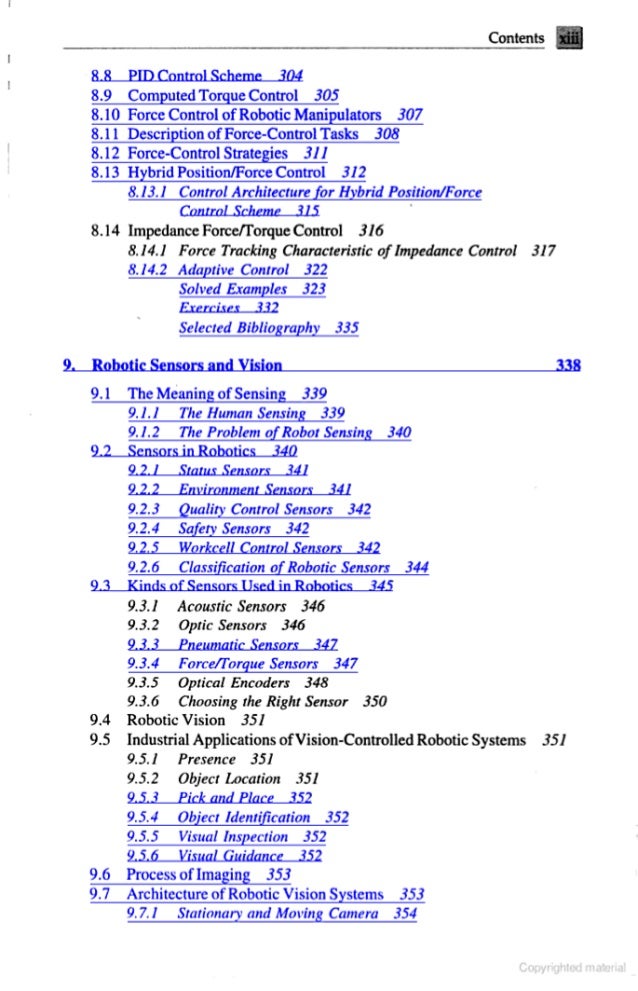
Robotics And Control Nagrath Mittal.pdf Free Download Here Subject Code: P8CSE5C ELECTIVE – V - 3. ROBOTICS http://www.bdu.ac.in/syllabi/affcol/equivalent/courses. Robotics and Control by RK Mittal Robotics Book By R K Mittal and I J Nagrath Robotics and Control Book Description: The book provides a compressive overview of the fundamental skills underlying the mechanism and control of manipulators. # Detailed chapter on Velocity Transformations, jacobian and Singularities.
Author by: Hubert Gattringer Languange: en Publisher by: Springer Science & Business Media Format Available: PDF, ePub, Mobi Total Read: 39 Total Download: 242 File Size: 45,6 Mb Description: The volume contains 19 contributions by international experts in the field of multibody system dynamics, robotics and control. Ribelle the brave italian. The book aims to bridge the gap between the modeling of mechanical systems by means of multibody dynamics formulations and robotics. In the classical approach, a multibody dynamics model contains a very high level of detail, however, the application of such models to robotics or control is usually limited. The papers aim to connect the different scientific communities in multibody dynamics, robotics and control. Main topics are flexible multibody systems, humanoid robots, elastic robots, nonlinear control, optimal path planning, and identification.
Author by: Antonio Bicchi Languange: en Publisher by: Springer Science & Business Media Format Available: PDF, ePub, Mobi Total Read: 39 Total Download: 480 File Size: 49,7 Mb Description: The?eld of robotics continues to?ourish and develop. In common with general scienti?c investigation, new ideas and implementations emerge quite spontaneously and these are discussed, used, discarded or subsumed at c- ferences, in the reference journals, as well as through the Internet. After a little more maturity has been acquired by the new concepts, then archival publication as a scienti?c or engineering monograph may occur. The goal of the Springer Tracts in Advanced Robotics is to publish new developments and advances in the?elds of robotics research – rapidly and informally but with a high quality. It is hoped that prospective authors will welcome the opportunity to publish a structured presentation of some of the emerging robotics methodologies and technologies.
The edited volume by Antonio Bicchi, Henrik Christensen and Domenico Prattichizzo is the outcome of the second edition of a workshop jointly sponsored by the IEEE Control Systems Society and the IEEE Robotics and Automation Society. Noticeably, the previous volume was published in the Springer Lecture Notes on Control and Information Sciences.
The authors are recognised as leading scholars internationally. A n- ber of challenging control problems on the forefront of today’s research in robotics and automation are covered, with special emphasis on vision, sensory-feedback control, human-centered robotics, manipulation, planning,?exible and cooperative robots, assembly systems. Author by: Peter Corke Languange: en Publisher by: Springer Science & Business Media Format Available: PDF, ePub, Mobi Total Read: 62 Total Download: 500 File Size: 41,5 Mb Description: The practice of robotics and computer vision both involve the application of computational algorithms to data. Over the fairly recent history of the fields of robotics and computer vision a very large body of algorithms has been developed. However this body of knowledge is something of a barrier for anybody entering the field, or even looking to see if they want to enter the field — What is the right algorithm for a particular problem?, and importantly, How can I try it out without spending days coding and debugging it from the original research papers?

The author has maintained two open-source MATLAB Toolboxes for more than 10 years: one for robotics and one for vision. The key strength of the Toolboxes provide a set of tools that allow the user to work with real problems, not trivial examples. For the student the book makes the algorithms accessible, the Toolbox code can be read to gain understanding, and the examples illustrate how it can be used —instant gratification in just a couple of lines of MATLAB code. The code can also be the starting point for new work, for researchers or students, by writing programs based on Toolbox functions, or modifying the Toolbox code itself.